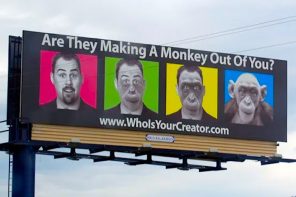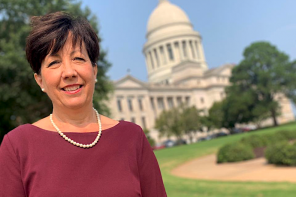Journalists, Scientists, and Lost Photographs from the Trial of the Century: Reframing Scopes, Marcel Chotkowski LaFollette (University Press of Kansas, 2008)
The trial has moved outside due to the oppressive heat. The judge and major players are on a stage framed by trees in front of the courthouse. Hundreds of townsfolk and media from around the nation, out of focus in the background’s bright harsh heat, have gathered to watch. Three of the most famous Americans of the time pose, frozen in the blurry brown and white of 1925. It’s the big face-off in the Scopes Trial in Dayton, Tennessee. There’s former presidential candidate William Jennings Bryan, sitting in the witness chair against all advice from his lawyers (one of whom is just behind Bryan with his head in his hands), to face questioning from America’s sharpest prosecutor, Clarence Darrow. Bryan looks up at the standing Darrow with a bemused smile on his face. Darrow, turned from the camera, pulls his suspenders, hunched and ready for the kill. And finally there’s the third, newly-minted celebrity, John Thomas Scopes, the back of his head focused in the foreground.
The photograph adorning the cover of Marcel Chotkowski Lafollette’s new book is rich and rife with energy and metaphor. Watson Davis, in this previously undiscovered picture, has brilliantly captured one of the most memorable moments in the last century of American history. It’s almost as if that’s all we need—just that one photograph. But LaFollette does write the rest of the book, and I’m glad.
LaFollette takes her goldmine of Davis’ photos (of everything from key players in the drama to ‘holy rollers’ in action to Model T-lined Dayton streets) and notes from Science Service reporters Davis and Frank Thone (which she uncovered in the Smithsonian archives) and lets them do the talking. Refreshingly, there is no intellectual prattling and wandering here; the book’s about the people, the moment, the context. LaFollette and the Science Service notes and pictures tell the story from the perspective of these two men on the scene who eventually lost all semblance of impartiality as journalists and wound up selling their stories of the trial to other media, advising the defense team, and generally hanging out at the headquarters of the defense; an old, quickly-refurbished house on the outskirts of Dayton.
The house is owned by George Washington Rappleyea, a transplanted New Yorker, who emerges as the architect of the whole trial in large part an effort to revitalize Dayton’s economy. We’re introduced to a panoply of intriguing characters (scientists, moderate religious leaders, theologians, wealthy patrons, and others in addition to the Darrows), who during the trial live at the defense headquarters and plot legal strategy.
This is history as I wish I’d learned it—illuminated through people, images, and good old soap-opera (e.g., a popular Dayton preacher, Howard Byrd, resigns in protest when his own congregation comes out against his invitation to a pro-evolution Christian cleric, in town for the trial, to preach in Byrd’s church), with extensive footnotes for further exploration and just enough suggestion to drive home how history never stops repeating itself. Regardless of the wealth of information on hand, we just keep doing the same thing over and over. Here we are more than eight decades after Scopes and little to nothing has changed in the science and religion conversation:
Similarly, without excessive words, ironies glare out from LaFollette’s history like the Dayton summer sun. A contemporary example: this book was published in Kansas, site of one of the most recent ‘battles.’ Another: the ACLU, a brand-new organization in 1925, supports the Scopes defense in the name of academic freedom, the same grounds intelligent design supporters like those in Kansas now often use to argue their ideas should be taught in the science classroom! Reframing Scopes is a light, enlightening, educational and engaging read. Check it out.
Visit our RDBook page for more reviews, and interviews with authors…



